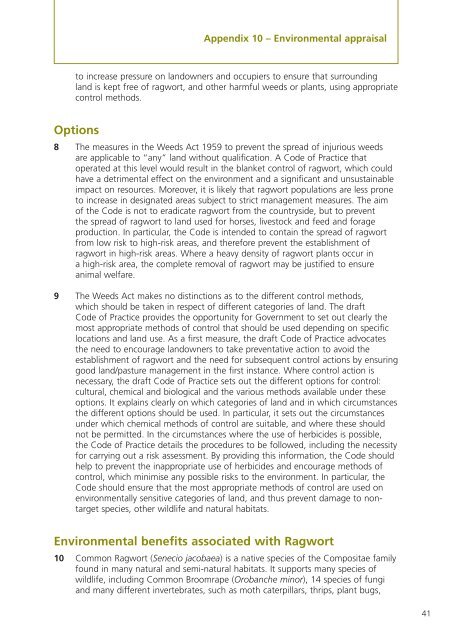code of practice on hopw to prevent the spread of ragwort - Defra
code of practice on hopw to prevent the spread of ragwort - Defra
code of practice on hopw to prevent the spread of ragwort - Defra
You also want an ePaper? Increase the reach of your titles
YUMPU automatically turns print PDFs into web optimized ePapers that Google loves.
<strong>to</strong> increase pressure <strong>on</strong> landowners and occupiers <strong>to</strong> ensure that surrounding<br />
land is kept free <str<strong>on</strong>g>of</str<strong>on</strong>g> <strong>ragwort</strong>, and o<strong>the</strong>r harmful weeds or plants, using appropriate<br />
c<strong>on</strong>trol methods.<br />
Opti<strong>on</strong>s<br />
Appendix 10 – Envir<strong>on</strong>mental appraisal<br />
8 The measures in <strong>the</strong> Weeds Act 1959 <strong>to</strong> <strong>prevent</strong> <strong>the</strong> <strong>spread</strong> <str<strong>on</strong>g>of</str<strong>on</strong>g> injurious weeds<br />
are applicable <strong>to</strong> “any” land without qualificati<strong>on</strong>. A Code <str<strong>on</strong>g>of</str<strong>on</strong>g> Practice that<br />
operated at this level would result in <strong>the</strong> blanket c<strong>on</strong>trol <str<strong>on</strong>g>of</str<strong>on</strong>g> <strong>ragwort</strong>, which could<br />
have a detrimental effect <strong>on</strong> <strong>the</strong> envir<strong>on</strong>ment and a significant and unsustainable<br />
impact <strong>on</strong> resources. Moreover, it is likely that <strong>ragwort</strong> populati<strong>on</strong>s are less pr<strong>on</strong>e<br />
<strong>to</strong> increase in designated areas subject <strong>to</strong> strict management measures. The aim<br />
<str<strong>on</strong>g>of</str<strong>on</strong>g> <strong>the</strong> Code is not <strong>to</strong> eradicate <strong>ragwort</strong> from <strong>the</strong> countryside, but <strong>to</strong> <strong>prevent</strong><br />
<strong>the</strong> <strong>spread</strong> <str<strong>on</strong>g>of</str<strong>on</strong>g> <strong>ragwort</strong> <strong>to</strong> land used for horses, lives<strong>to</strong>ck and feed and forage<br />
producti<strong>on</strong>. In particular, <strong>the</strong> Code is intended <strong>to</strong> c<strong>on</strong>tain <strong>the</strong> <strong>spread</strong> <str<strong>on</strong>g>of</str<strong>on</strong>g> <strong>ragwort</strong><br />
from low risk <strong>to</strong> high-risk areas, and <strong>the</strong>refore <strong>prevent</strong> <strong>the</strong> establishment <str<strong>on</strong>g>of</str<strong>on</strong>g><br />
<strong>ragwort</strong> in high-risk areas. Where a heavy density <str<strong>on</strong>g>of</str<strong>on</strong>g> <strong>ragwort</strong> plants occur in<br />
a high-risk area, <strong>the</strong> complete removal <str<strong>on</strong>g>of</str<strong>on</strong>g> <strong>ragwort</strong> may be justified <strong>to</strong> ensure<br />
animal welfare.<br />
9 The Weeds Act makes no distincti<strong>on</strong>s as <strong>to</strong> <strong>the</strong> different c<strong>on</strong>trol methods,<br />
which should be taken in respect <str<strong>on</strong>g>of</str<strong>on</strong>g> different categories <str<strong>on</strong>g>of</str<strong>on</strong>g> land. The draft<br />
Code <str<strong>on</strong>g>of</str<strong>on</strong>g> Practice provides <strong>the</strong> opportunity for Government <strong>to</strong> set out clearly <strong>the</strong><br />
most appropriate methods <str<strong>on</strong>g>of</str<strong>on</strong>g> c<strong>on</strong>trol that should be used depending <strong>on</strong> specific<br />
locati<strong>on</strong>s and land use. As a first measure, <strong>the</strong> draft Code <str<strong>on</strong>g>of</str<strong>on</strong>g> Practice advocates<br />
<strong>the</strong> need <strong>to</strong> encourage landowners <strong>to</strong> take <strong>prevent</strong>ative acti<strong>on</strong> <strong>to</strong> avoid <strong>the</strong><br />
establishment <str<strong>on</strong>g>of</str<strong>on</strong>g> <strong>ragwort</strong> and <strong>the</strong> need for subsequent c<strong>on</strong>trol acti<strong>on</strong>s by ensuring<br />
good land/pasture management in <strong>the</strong> first instance. Where c<strong>on</strong>trol acti<strong>on</strong> is<br />
necessary, <strong>the</strong> draft Code <str<strong>on</strong>g>of</str<strong>on</strong>g> Practice sets out <strong>the</strong> different opti<strong>on</strong>s for c<strong>on</strong>trol:<br />
cultural, chemical and biological and <strong>the</strong> various methods available under <strong>the</strong>se<br />
opti<strong>on</strong>s. It explains clearly <strong>on</strong> which categories <str<strong>on</strong>g>of</str<strong>on</strong>g> land and in which circumstances<br />
<strong>the</strong> different opti<strong>on</strong>s should be used. In particular, it sets out <strong>the</strong> circumstances<br />
under which chemical methods <str<strong>on</strong>g>of</str<strong>on</strong>g> c<strong>on</strong>trol are suitable, and where <strong>the</strong>se should<br />
not be permitted. In <strong>the</strong> circumstances where <strong>the</strong> use <str<strong>on</strong>g>of</str<strong>on</strong>g> herbicides is possible,<br />
<strong>the</strong> Code <str<strong>on</strong>g>of</str<strong>on</strong>g> Practice details <strong>the</strong> procedures <strong>to</strong> be followed, including <strong>the</strong> necessity<br />
for carrying out a risk assessment. By providing this informati<strong>on</strong>, <strong>the</strong> Code should<br />
help <strong>to</strong> <strong>prevent</strong> <strong>the</strong> inappropriate use <str<strong>on</strong>g>of</str<strong>on</strong>g> herbicides and encourage methods <str<strong>on</strong>g>of</str<strong>on</strong>g><br />
c<strong>on</strong>trol, which minimise any possible risks <strong>to</strong> <strong>the</strong> envir<strong>on</strong>ment. In particular, <strong>the</strong><br />
Code should ensure that <strong>the</strong> most appropriate methods <str<strong>on</strong>g>of</str<strong>on</strong>g> c<strong>on</strong>trol are used <strong>on</strong><br />
envir<strong>on</strong>mentally sensitive categories <str<strong>on</strong>g>of</str<strong>on</strong>g> land, and thus <strong>prevent</strong> damage <strong>to</strong> n<strong>on</strong>target<br />
species, o<strong>the</strong>r wildlife and natural habitats.<br />
Envir<strong>on</strong>mental benefits associated with Ragwort<br />
10 Comm<strong>on</strong> Ragwort (Senecio jacobaea) is a native species <str<strong>on</strong>g>of</str<strong>on</strong>g> <strong>the</strong> Compositae family<br />
found in many natural and semi-natural habitats. It supports many species <str<strong>on</strong>g>of</str<strong>on</strong>g><br />
wildlife, including Comm<strong>on</strong> Broomrape (Orobanche minor), 14 species <str<strong>on</strong>g>of</str<strong>on</strong>g> fungi<br />
and many different invertebrates, such as moth caterpillars, thrips, plant bugs,<br />
41
















